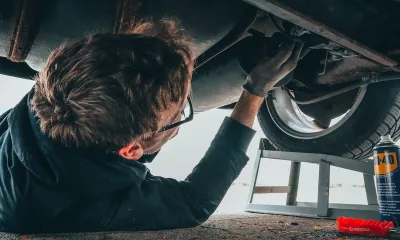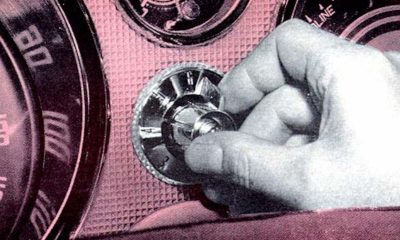Mounting concern
Putting the engine in its place…
Engine mountings are usually forgotten items. They’re out of sight and do not add to the glamour of an under-bonnet view in the same way that a set of twin-cam covers does. They are, however, very necessary items because they isolate the passenger cabin from the vibrations and shudders an engine goes through while it’s delivering power.
HISTORY
In the early days of motoring an engine’s cylinder block was usually supported by four extensions, two on each side, that were bolted directly to the chassis side rails.
These were either bolted to the block or cast as part of the block. The gearbox would normally be mounted separately, with a short shaft linking it to the engine. This was done to give torsional strength to the front of the chassis, because the position of the engine made it impossible to stiffen the side rails any other way.
This arrangement had two major disadvantages. It transmitted most engine vibration directly into the cabin, and led to a number of designs suffering from the effects of crankcase distortion, such as fractured engine castings and crankshaft bearing failures. Engine vibration was just something that motorists had to live with, but mechanical failures were as annoying as they are today.
By the ’20s motorists had started to become more fussy and vibration had to be reduced. The easiest way was to introduce rubber blocks between the mounting arm and the chassis side rail. In most cases this stopped the mechanical failures but often made the vibrations even worse, partly because the wrong rubber mix was used and partly because the mountings were in the wrong position.
THE PROBLEM
The time had arrived to study the problem more scientifically. One of the reasons for the way an engine vibrates is that the motions of the pistons and crankshaft can only be partially balanced by adding balance masses to the rotating parts.
The success of such efforts depends to a large extent on the number of cylinders, which explains why, for example, sixcylinder engines tend to be smoother than four-cylinder units. Another reason is the power pulses that occur at every combustion event. These act like hammer blows on the crankshaft and induce a torsional vibration that tends to make the crankshaft shake the way a wet dog tries to get rid of the water on its coat.
Engine mountings have to comply with a number of conflicting requirements:
1. They have to support the combined mass of the engine and gearbox.
2. They have to isolate the passenger compartment from engine vibration and to some extent even noise. For this purpose the mounting should be fairly soft and the damping should be light but should take care of small amplitudes at high frequencies.
3. They have to isolate the body from shock loads in the drivetrain due to abrupt acceleration and deceleration, as well as from bumpy roads. To perform this duty the mounting should be stiff and the damping heavy.
SOURCES OF VIBRATION
An engine vibrates in a number of different ways, but the major external modes that the mountings have to deal with are:
1. An up and down linear movement caused by either primary or secondary imbalance.
2. A torsional movement caused by a reaction to the engine developing torque. This is about an axis parallel to the crankshaft axis, when seen from the top, but angled upwards at the front of the engine (see floating power sketch above).
3. A torsional movement at right angles to the reaction in item 2 caused by unbalanced primary and secondary couples.
BACKGROUND THEORY
All bodies have a centre of gravity. This is the point through which all the forces acting on a body can be considered to act if the dimensions of the body are not relevant to the problem being solved.
Through this point one can also theoretically draw three mutually perpendicular axes around which any rotation of the body can be considered to take place. These are known as the principal axes, and their location depends on the shape of the body.
The longitudinal principal axis of an engine/gearbox unit is close to being parallel to the crankshaft centreline when viewed from the top, but inclined rearwards when viewed from the side. The angle results from the fact that this is also the line between the centres of gravity of the engine and gearbox, and these two points are obviously at different heights above the road.
POSITIONING THE MOUNTINGS
Modern engine mountings are usually positioned somewhere on the longitudinal principal axis, or on the transverse principal axis, which is usually parallel to the road, when viewed from the front.
This means they’re in what batsmen call the “sweet spot”, which is a position where no vibration is felt, so it cannot be transmitted. Chrysler is usually credited for pioneering this step in 1932 with its floating power mountings.
Longitudinal engine layouts usually employ a mounting on each side of the engine, as well as a single mounting at the rear underneath the gearbox. Transverse layouts usually have a high mounting on the accessory drive side of the engine and a lower mounting at the other side, but both will be on the principal axis.
Sometimes a third mounting, or even a stay, is also needed because a transverse engine/gearbox unit cannot be allowed to rotate as much as a longitudinal unit. Any significant movement will break the exhaust pipe and derange throttle and other connections.
RUBBER MOUNTINGS
A conventional rubber/steel unit cannot satisfy all the requirements of a modern mounting because the stiffness and damping characteristics do not change much with the amplitude and frequency of the exciting forces.
These mountings can take a number of different shapes, depending on how and where they’re used. Most take the form of rubber sandwiched between steel plates, and most of them are mounted at an angle so that the rubber works in compression as well as shear.
HYDRAULIC MOUNTINGS
This is a liquid-filled mounting that works like a rubber unit at low amplitudes and a suspension damper at higher amplitudes.
This means that the stiffness and damping changes with the amplitude of the vibration. However, these units are expensive, heavy, and complicated.
The interior of a typical hydro-mount, as it is called, has two chambers filled with glycol. The fluid is able to move between the chambers, either through an orifice or a damping channel.
The upper chamber is surrounded by a steel casing and the chamber housing is formed like a rubber spring. It is strong enough to support the load placed on it by the engine/ transmission unit. Any movement of the load also acts to deform this chamber so that it then acts like a pump to transfer some of the fluid to the lower chamber.
The lower chamber is made of a softer rubber, because it has to absorb any transferred fluid without increasing its pressure significantly. When a vibration of the correct amplitude occurs, the upper chamber housing changes shape so that the resulting decrease in volume tries to force fluid through the channel to the lower channel.
This channel is in the shape of a lengthy spiral, with the result that, as the speed of fluid transfer increases, the amount of fluid that gets through to the lower chamber decreases. At high frequencies no fluid gets through.
The orifice is a small opening in a plastic plate mounted between the upper and lower chambers. At low-amplitude vibrations, most of the fluid transfer takes place through the orifice, but the orifice is too small to handle larger amplitudes so, at some point, all fluid transfer takes place through the channel. A combination of channel size, shape, and orifice size is used to calibrate such a unit for any particular range of vibrations.
On some units the damping characteristics can be changed by electrically operated valves, similar to the way some suspension dampers work.
ELECTRONIC MOUNTINGS
Electronic mountings operate on the principle that waves can interfere with each other in such a way that they cancel each other. Earlier this year ContiTech, a part of the Continental tyre group, presented such an active mounting.
The mounting consists of two electric actuators, an amplifier and two sensors. When the sensors detect a vibration they measure its amplitude and frequency and then cause the actuators to send out the exact opposite vibration with the same parameters. The result is that the initial vibration is killed.
The amount of vibration felt by passengers is one of the last major differences between the various models on the market. Soon most cars will be fitted with electronic mounts and most of these differences will disappear. Just another step on the road towards making cars without personality…






